Sasol pioneers: Dr Hendrik van Eck and Etienne Rousseau
Dr Hendrick van Eck had a doctorate in engineering and played a vital role in establishing the early South African industry in the twentieth century. He took a keen interest in coal gasification and oil-from-coal possibilities as the Managing Director and Chairman of the Industrial Development Corporation through which the South African Government financed Sasol. He was the first vice-chairman of Sasol.
In 1938 Dr Van Eck appointed Etienne Rousseau, the father and first employee of Sasol, as a research engineer at Satmar, The South African Torbanite Mining and Refining Company (Satmar), owned by Anglovaal and the British Burmah Company. They were to mine oil-shale in the Ermelo district, distil the oil off the shale by heating it in retorts and then to refine the oil in Boksburg. In 1945 Anglovaal applied to the South African Government for a licence to produce oil-from-coal. In a press statement in September 1946, the South African Government, through the Fuel Committee of the Department of Commerce and Industries, gave Anglovaal certain assurances, provided that the new industry should be competitive in price and quality with imported material.
In 1946 Etienne Rousseau was asked to work on the oil-from-coal project.
On 13 January 1948, Etienne Rousseau was appointed to the Liquid Fuel and Oil Industry Advisory Board in terms of the Liquid Fuel and Oil Act of 1947. The Act made its establishment subject to a licence to be issued by the Government. On 17 January 1948 the Board started considering Anglovaal’s application for a licence to manufacture liquid fuel and oil from coal. As it would have been very difficult for Anglovaal to raise the capital to start the venture, Rousseau was convinced it should be a national undertaking. Anglovaal obtained their licence on 29 July 1949.
In February 1950 Etienne Roussseau was approached to become managing director of a company to be formed for the purpose of making oil from coal. Anglovaal transferred all rights under the oil-from-coal licence, all rights accruing from the licence agreements and all coal rights to an interim committee, with the South African Government, Industrial Development Corporation and Anglovaal as members.
Etienne Rousseau proposed the name: South African Synthetic Oil Limited – SASOL – to the committee. The short version was popular, but the official name became the South African Coal, Oil and Gas Corporation Ltd, established on 26 September 1950 as a government-sponsored public company.
First Sasol offices
Sasol’s first offices were established in the Zevenfontein farmhouse in early 1951 on the proposed site for the new Sasol town near Coalbrook. The house still stands in Hertzog Street in Sasolburg.
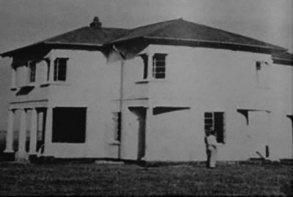
Sasol's first offices
Sigma Colliery
On 16 October 1951 mining preparations began. The mining operations were referred to as the Sigma Colliery, which refers to the Greek letter ‘S’ for Sasol.
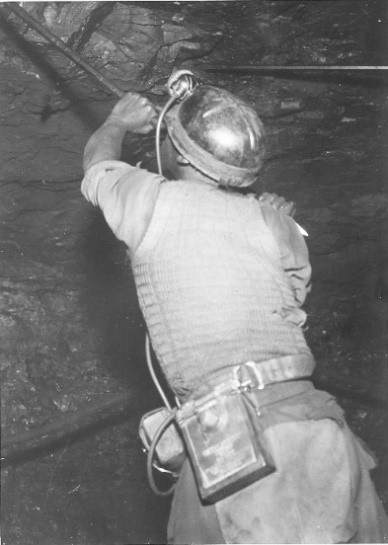
A miner operating underground at the Sigma Colliery
Sasol processes
Construction on the Sasol plant in Sasolburg started in the middle of 1952, with the first units coming into operation in 1954. By the end of 1955 all the main construction work of Sasol’s first phase had been completed.
Sasol invested in the American Kellogg (Synthol) and German Ruhrchemie-Lurgi (Arge) synthesis processes in a two-thirds American and one-third German ratio. The American engineers oversaw coordination and construction, combining the two processes on the Sasol plant in Sasolburg.
The Synthol reactors, with their powdered iron-based catalyst that circulated as a moving fluidised bed process, produced higher proportions of medium octane petrol, liquefied petroleum gas and chemicals. Whilst the Arge process used a pelletised iron catalyst, through which the reacting gas stream passed. The Arge process produced different categories of product streams including higher boiling point materials, consisting of waxes and medium boiling-range oils such as diesel, along with low proportions of petrol, liquefied petroleum gas, oxygenated products and furnace oils.
Through the Synthol process, in March 1955 the first gasification product, a drum of creosote, was delivered at Sasol I and at 13:30 on 23 August 1955 Sasol produced its first petrol in its Synthol reactors. By the end of the year, cars could fill up with Sasol petrol. This remarkable achievement was commemorated by an annual car rally through the streets of Sasolburg, for many years.
The combination of the two processes enabled Sasol to produce a wide variety of petrochemical products.
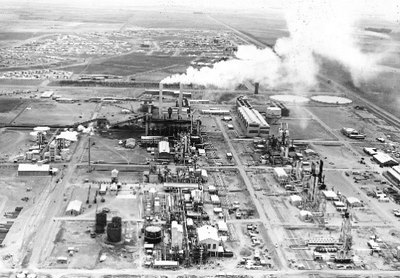 |
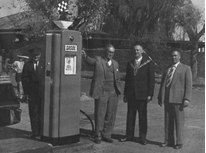 |
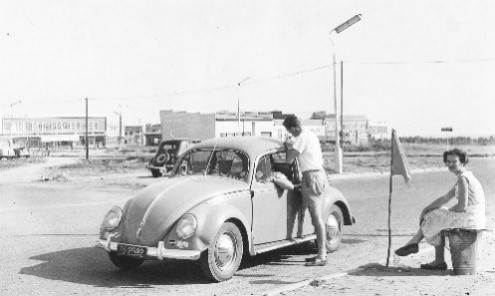 |
| Construction of Sasol one | First 'blue pump' | Rally cars back in the day |
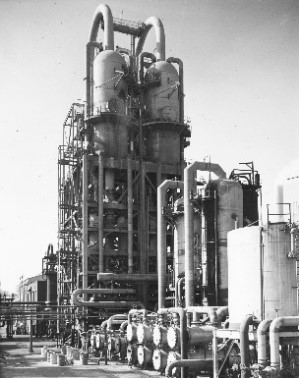 |
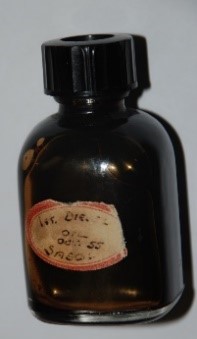 |
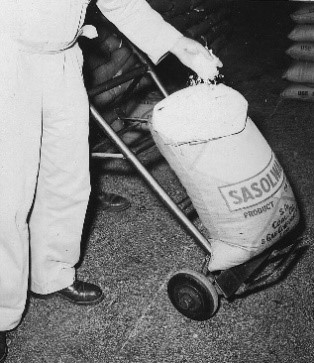 |
| Synthol reactors | Sasol produced its first diesel oil in October 1955 | one of the first bags of wax Sasol produced in 1955 |
Evolution of Sasol in Sasolburg
In 1988, the Sasol One site transitioned its operations into chemical production exclusively, leading to the decommissioning of the Synthol reactors. The Arge plant became the primary plant on the Sasol One site.
Sasol Slurry Phase Distillate
The first full-scale Sasol Slurry Phase DistillateTM (SSPD) Fischer-Tropsch reactor was commissioned at Sasolburg in 1993, which vastly increased Sasol’s wax production capacity.
Another significant change to Sasol’s operations in Sasolburg, occurred in 1994 when Sasol formed a Joint Venture (Polifin) with AECI. In 1999 Sasol bought AECI’s share and the site is today known as Sasolburg Operations’ Midlands Site.
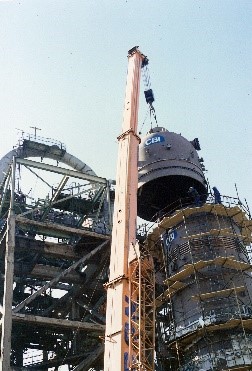
SSPD
Conversion to natural gas as feedstock
The Sasol One site converted to using natural gas as feedstock in 2004, seeing the closure of Gasification and Gas Reform.
Apart from the infrastructure to feed the natural gas from Mozambique to Sasolburg, two Auto Thermal Reformer (ATR) trains were constructed to supply synthesis gas to the wax plants.
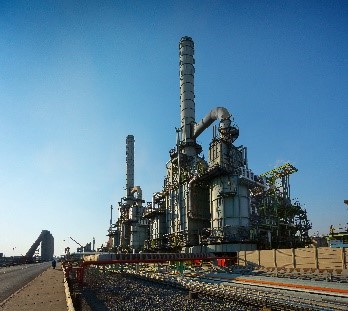
ATR
Mega Projects
Several expansion projects were implemented in Sasolburg in 2010. The most significant of these were:
- A major wax expansion project, the Fischer-Tropsch Wax Expansion Project (FTWEP);
- The Ethylene Purification Unit 5 (EPU5) project; and
- The Sasol Gas Engine Power plant.
On 17 March 2011 the first of two third-generation reactors were lifted into position as part of the extensive Fischer-Tropsch Wax Expansion Project (FTWEP) that doubled Sasol’s production of hard wax in South Africa.
The Sasol Gas Engine Power Plant reached Beneficial Operation (BO) in 2012, supplying 140 MW electricity, primarily to cater for the two new production facilities on the site.
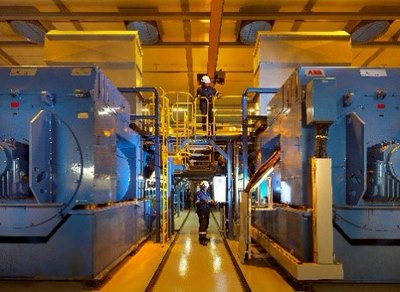
Gas Engine power plant
- The Ethylene Purification Unit 5 was commissioned in 2014.
- The second reactor was lifted into place on 2 August 2014.
- With the new wax facilities coming into production, the old Arge reactors were decommissioned on 22 November 2016.
- The commissioning and inauguration of FTWEP took place in 2018.
Today, our Sasolburg Operations still maintain a focus on high-value chemicals. The Sasol One Site produces ammonia, ammonium nitrate, catalyst, ethylene, mining chemicals, phenolics, solvents and wax. It also provides utilities and generates electricity. The Sasol Midlands Site produces acrylic acids, caustic, chlorine, cyanide, HCL, n-Butanol, Polyethylene (LLDPE and LDPE) and PVC. The Sasol Bunsen Site produces nitric acid. The SGEPP (Sasol Gas Engine Power Plant) and Steam Station 2 sites, produce steam and generates electricity.
Sasol in Secunda
By 1973 the Sasolburg complex was running efficiently. But as crude oil prices skyrocketed later that year, the need for South Africa to become less reliant on imported crude oil increased. On 5 December 1974, it was announced that Sasol would build a second industrial site.
On 28 June 1976 Secunda (Latin for ‘second’) was officially proclaimed a town. The site, 120 kilometres south-east of Johannesburg, was strategically chosen close to coal deposits and with access to water supply.
Construction of Sasol Two was completed in July 1980 and shortly after approval to build Sasol Three (a replica of Sasol Two) was granted. At the time, it was the world’s largest single petrochemical complex construction site. In the following years Sasol Two and Sasol Three effectively merged into the regional operating hub of today.
Secunda Chemicals Operations (SCO)
Secunda Chemicals Operations (SCO) comprises all our Secunda-based chemical operating facilities. Its diverse product range includes industrial explosives, fertilisers, polypropylene, ethylene, propylene, solvents (acetone, methyl ethyl ketone (MEK)), ethanol, n-Propanol, isopropanol, Sabutol™, Propylol™, mixed C3/C4/C5/C6 alcohols, high-purity ethanol and ethyl acetate as well as co-monomers (1-hexene, 1-pentene and 1-octene) and detergent alcohol (Sasol™). In addition, SCO provides site services, infrastructure maintenance and product logistics services for the Secunda site.
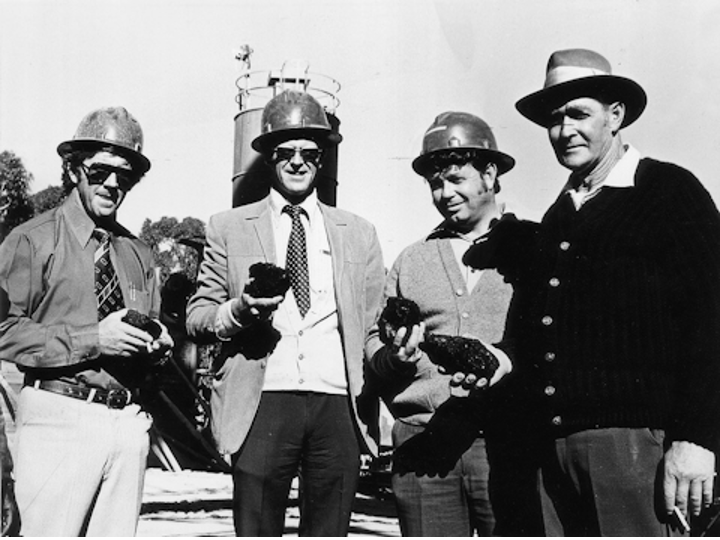
First coal out of Secunda
Mining
Sasol Mining operates six coal mines in the world’s largest underground coal mining complex, supplying feedstock for the Southern African integrated value chain. Of the coal supplied to Secunda Synfuels Operations (SSO) most is used as gasification feedstock, while some are allocated to electricity generation.
Group Technology
Sasol’s Natural Gas Programme - A story
In 2004, Sasol commissioned the US$1,2 billion Natural Gas Project that saw natural gas being produced in Mozambique sent by pipeline to South Africa. This project has formed the backbone of the Southern African gas market, supplying customers in both countries
The Sasol Natural Gas Project (SNGP) was built on three primary aims. First, to use the previously stranded Mozambique natural gas as replacement feedstock for Sasolburg chemicals operations. Secondly, to grow the southern African energy marks and, thirdly, to supplement coal as feedstock for Secunda’s fuels and chemicals operations.
The main physical components of the Sasol Natural Gas Project (SNGP) included the field developments in Temane and Pande; establishing a new Central Processing Facility at the selected Temane site; building the 865km Mozambique Secunda Pipeline (MSP); converting Sasol’s pipeline network to Natural Gas; transforming of the Sasolburg SCI plant to natural gas and converting multiple downstream gas consumers to the higher energy-value natural gas. All this, with a budget of approximately $1,1 million.
The SNGP has proven to be an unqualified success. It established the first natural gas supply chain in Southern Africa and has been the subject of several capacity expansions to various new markets including gas to power. It has unceasingly delivered gas for over 16 years to consumers down the line. The SNGP is also seen to be providing a substantial basis for continuing reductions in Sasol’s carbon footprint into the future. The technology and lessons learned on the program were also applied to, amongst others, the Qatar Oryx GTL plant completed a few years later.
Sasol Advanced Synthol reactor commercialisation
An integrated understanding of basic reactor hydrodynamics, heat transfer and catalyst particle dynamics resulted in the development from circulating fluidized bed (CFB) to a more compact fixed fluidised bed reactor design, termed the Sasol Advanced Synthol (SAS) reactor. This understanding was developed, based on fused iron catalyst, from a 1m diameter demonstration unit in 1983, through a 5m reactor in 1989, to the replacement of CFB reactors with 4 x 8m and 4 x 10.7m SAS reactors, completed in 1999. An 8m ninth SAS reactor was thereafter added in 2002. The process was then configured to run in a series or parallel mode to increase conversion and plant capacity within the constraints of the facility from 2004 to 2005. An 8m tenth SAS reactor was finally added to the process in 2011.
These reactors form the basis of the Secunda Synfuels operations in converting synthesis gas into a Fischer-Tropsch synthetic crude feed stream for fuels and chemicals.
The Energy Journey
Retail sites
Since our first pump in Sasolburg, Sasol’s retail footprint expanded to over 400 retail sites across South Africa. The most recent Sasol Marshall in Polokwane came onstream on 26 August 2020.
Our flagship site Sasol Malanshof in Johannesburg was the first Sasol site in our network, opening for business in 2003.
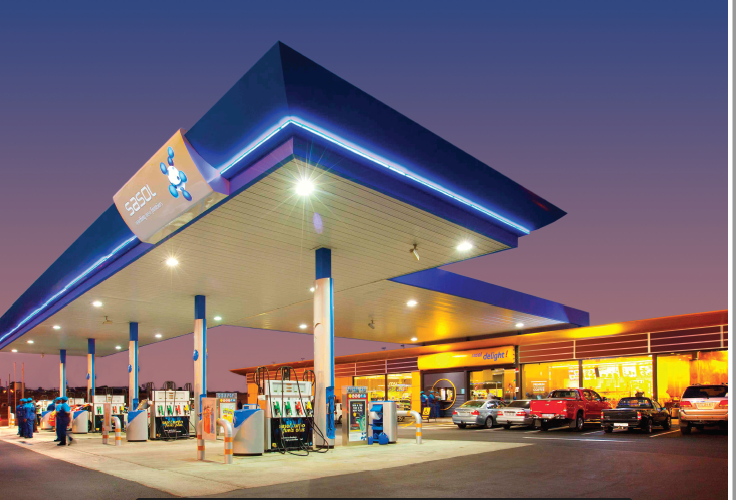
Sasol Malanshof
Sasol Motorsport
Sasol started its relationship with South African motorsport in 1962, and over the decades we have been involved in all aspects of motorsport, from rally and circuit racing to Formula 1.
Sasol was the title sponsor of the Jordan Yamaha Formula One team for the 1992, 1993 and 1994 seasons. Sasol was required to provide fuel as part of the sponsorship agreement Sasol’s Fuels Technology group (at the time Sasol Oil: Fuels Research & Development) was tasked with formulating the racing fuel.
The engine test facilities available to Sasol are now significantly more advanced than those utilised in the early 1990s and include state-of-the-art exhaust emissions measurement systems. The company’s understanding of environmental concerns, engine emissions and low-carbon fuels can be used in a similar way to that utilised to produce the superior Formula One fuel, to formulate an environmentally sensitive fuel that meets the demanding requirements of the modern World Rally Championship powertrain.
Our involvement with the South African Rally Championship began in 1991 and we are proud to be regarded as one of the pioneers in the development of racing fuel. The Sasol Rally created a platform to test both lubricants and fuel products under stringent conditions. Our Research & Development capabilities enabled us to design fit-for-purpose products to be tested at the rally. Our 25-year sponsorship of the Sasol Rally ran until early 2017.
The Sasol circuit racing sponsorship included stints with Subaru, Audi, and BMW and came to an end in early 2019.
Sasol Fuels Application Centre
On 26 June 2009, Energy Technology’s Sasol Fuels Application Centre (SFAC) was opened in Cape Town by the then Sasol CEO, Pat Davies; Minister of Science and Technology, Naledi Pandor; and the Premier of the Western Cape, Helen Zille.
The facility has played an important role in ensuring that Sasol’s products meet the highest quality and performance standards, contributing to Sasol’s legacy over the years. Research carried out at the facility ensured a seamless introduction of GTL diesel into the market. The facility’s work now focuses on the South African market to ensure that our products are developed to the highest standards and rigorously tested under local conditions. This is achieved through successful collaborations with many local and international stakeholders including fuel additive suppliers, universities, automotive companies, local mining houses and other research organisations worldwide.
Approval of synthetic jet fuel
Until 1998, the only jet fuel that was approved globally for commercial use was Jet A/A-1 derived from crude oil. The need for approval of alternative fuels was identified in South Africa in the early 1990s and Sasol started discussions with jet fuel specification authorities (ASTM in USA and AFC in the UK) to gain approval for the commercial use of synthetic jet fuel. The Sasol team led a process, which included extensive laboratory and engine test work in South Africa and the USA to gain approval for the use of a 50 percent synthetic jet fuel component in a crude derived jet fuel. In 1998, iso-paraffinic kerosene (IPK), produced by Sasol Synfuels in Secunda, was included in the UK MoD specification (DEF STAN 91-091) and in February 1999, the first batch of Sasol semi-synthetic jet fuel was certified at Natref refinery. In September 2009, a new ASTM specification, ASTM D7566 (Aviation Turbine Fuel containing Synthesised Hydrocarbons) was approved. Since 1999 up to today, this semi-synthetic jet fuel, containing up to 50 percent FT-SPK, are supplied to the Johannesburg International Airport.
The Fuels Technology team led a process which included extensive laboratory and engine test work in South Africa and the USA to gain approval for the use of a 50 percent synthetic jet fuel component in a crude derived jet fuel. In 1998, iso-paraffinic kerosene (IPK), produced by Sasol Synfuels in Secunda, was included in the UK specification and in February 1999, the first batch of Sasol semi-synthetic jet fuel was certified at Natref refinery. In September 2009, a new ASTM specification, ASTM D7566 (Aviation Turbine Fuel containing Synthesised Hydrocarbons) was approved.
Between 2001 and 2007, extensive laboratory and engine tests were carried out on blends of potential jet fuel streams at Sasol Synfuels and in April 2008, the formal approval for Sasol Synfuels’ fully synthetic jet fuel was published and subsequently included in the USA jet fuel specification. Sasol’s synthetic jet fuel was subsequently approved for commercial use in South Africa. In 2010, Sasol conducted the world’s first passenger flight using fully synthetic jet fuel from Johannesburg to Cape Town in a jet aircraft.
Sasol’s Synthetic jet fuel takes to European skies
Sasol collaborated with the German Aerospace Center (Deutsches Zentrum für Luft- und Raumfahrt; DLR) to investigate potential ways that alternative fuels could be formulated to reduce the impact of air transport on our climate. Six different certified jet fuels were used during the investigation, including Sasol’s Semi-synthetic (SSJF) and Fully Synthetic Jet Fuel (FSJF). It was the first time that FSJF took off in Europe.
GTL Challenge – Sasolburg to Doha Expedition
In 2006, a convoy of five vehicles travelled from Sasolburg to Doha. The inspiration behind this expedition was the symbolic passage of Sasol’s technology across Africa - from where it was originally developed in Sasolburg to Qatar in the Middle East, where it was been taken to the next stage of commercial development.
A convoy of five vehicles, provided by Toyota, drove from Sasolburg to Ras Laffan Industrial City. One vehicle in the convoy, a Toyota Hilux Raider, operated entirely on GTL diesel for the length of the trip, while the remaining four vehicles were fuelled with normal, crude derived diesel. The expedition was used to educate the world about the use of superior environmentally friendly GTL diesel.
Natref
Natref, South Africa's only inland crude oil refinery is a medium sized technologically advanced refinery, highly efficient in refining heavy crude oil. The Natref refinery is a joint venture between SasolOil (Pty) Ltd and Total South Africa (Pty) Ltd.
Commissioned in 1971, the Natref refinery at Sasolburg has been at the cutting edge of refining technology since its inception. Situated inland, near the industrial heartland of South Africa, Natref (National Petroleum Refiners of SOuth Africa) was no ordinary refinery.
With its inland location the refinery's market for heavy fuel oil was quite limited. As a result, it was designed to get the most out of crude oil and equipped with state-of-the-art technology. The refinery uses the bottoms up grading refining process using medium gravity crude oil and giving the refinery the capability of producing 70 percent more white product than coastal refineries that have to rely on heavy fuel oil.
Conversion of vacuum residue to white products (diesel, petrol, jet fuel and LPG) was a necessity from the start. Thus, in addition to a conventional fluid catalytic cracking (FCC) unit, the refinery was equipped with a distillate hydrocracker (DHC) and a black oil hydrocracker (BOC).
During the ensuing years, Natref has undergone a series of upgrading programmes. In 1993 some R450 million was spent on an upgrade and expansion project.
Sasol Oil has a 63,64 percent interest in Natref and Total South Africa a 36,36 percent shareholding. A technical agreement exists between Natref and the Total Group.
Satellite Operations Ekandustria
Sasol Satellite Operations Ekandustria is an explosives and explosives accessories manufacturing company, located approximately 50km east of Pretoria. The site produces six different product lines of explosives and explosive accessories with nine different plant areas. The site is a labour-intensive batch manufacturing Sasol location with approximately 900 people on site.
Our International Heritage
Over the decades, as technology has advanced, Sasol’s spirit of innovation saw it develop its chemicals products. Seeking global expansion, Sasol bought Conde Vista in 2001 to expand its geographical footprint and complement Sasol’s portfolio of patented technologies to produce speciality chemicals. This provided Sasol with key platforms from which to expand its presence in Europe and North America. Following this milestone, Sasol listed on the New York Stock Exchange in 2003.
Mozambique Natural Gas Project – a milestone in regional energy and infrastructure development
As part of Sasol’s 70-year celebration, we also celebrate an incredible milestone that is the Mozambique natural gas project which initiated a much-needed broadening of the energy supply mix in the region and has positively impacted both the Mozambican and South African economies.
The first gas fields to be discovered in Mozambique were in the Pande and Temane fields in 1961 and 1967 respectively. These assets were effectively underutilised until Sasol initiated a US$1.2 billion project, together with its partners, Companhia Moçambicana de Hidrocarbonetos and International Finance Corporation. The project was enabled by the Production Petroleum Agreement (PPA) license, which involved the processing of natural gas at the Central Processing Facility (CPF) in Temane, near Vilanculos in Southern Mozambique which came online in 2004. Sasol has since produced over two trillion cubic feet (Tscf) of raw gas from the Pande and Temane fields with current production from the fields approximating 500 million standard cubic feet per day.
The development of the Pande and Temane fields includes a total of 26 natural gas producers connected to the CPF. The gas is transported to Mozambique and South African markets through the 865-kilometre-long Mozambique Secunda Pipeline.
In conjunction with our partners, our contribution to Mozambique over the years has been a catalyst for socio-economic growth through cumulative direct contributions to government, capital investments and spin-offs from secondary industries, tax revenue as one of the largest taxpayers in the country, revenue generated from equity investments, training and development of Mozambican nationals and development of communities.
In terms of our socio-economic development, we believe that driving mutual benefit and accelerating socio-economic growth for the countries in which we operate is critical. Our commitment to delivering social value extends beyond our factory fence line to neighbouring communities where we develop and promote people-centred, long-term sustainable programmes.
We have continued to show our commitment to ensuring that the country’s natural resources benefit its citizens. Sasol’s upstream investment in Mozambique forms the cornerstone of our value chain in Southern Africa and could not have happened without a huge effort from integrated teams within Sasol, our partners and the greater community of Mozambique. This is one of most remarkable accomplishments to reflect on as we celebrate our 70 years of existence, particularly as Team Sasol looks forward to the future by pursuing gas as a key enabler to achieve our strategic objectives.
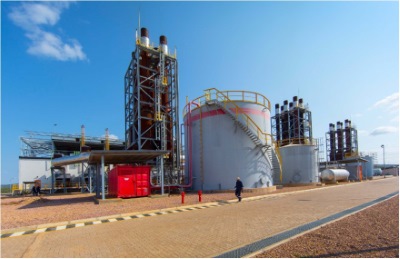
Mozambique CTRG
GTL Development the Oryx story
Together with our partners, Qatar Petroleum, Sasol commissioned ORYX GTL in 2007, one of the world’s first commercial scale gas-to-liquids (GTL) facilities to produce virtually sulphur free diesel, kerosene and naphtha.
Qatar was developing the vast North gas field and wanted to diversify their monetisation strategy and quickly became interested in Sasol’s new GTL process. This represented an exciting opportunity for many engineers and scientists as the new process required developing new FT catalyst; piloting and scale-up of the catalyst in the slurry bed reactor, scale-up of the reactor from the 2500 bbl/day to 17000 bbl/d and the establishing an overall integrated GTL flow sheet with the supporting utility system, in a very short time frame.
Oryx GTL felt like a truly global effort. It was not uncommon to have the Research & Development team working in Sasolburg on the catalyst and reactor development, the Single Point Licensing (SPL) team in Reading, UK working on the integrated flowsheet development with Foster Wheeler, a Sasol representative in Copenhagen, Denmark for the reformer integration, the FT licensor in Boston, U.S. with the reactor scale-up and then other Sasol representatives in San Francisco for the refinery flowsheet development. During the project’s detail design phase, Sasol representatives in Rome, Italy as well as some in Yokohama, Japan for the FT reactor fabrication. With the last stage of the project on site in Las Raffan, Qatar.
With oil prices peaking at above $150/bbl during 2008, the facility turned highly profitable, enabling the Joint Venture to repay the loan within about one year thereafter.
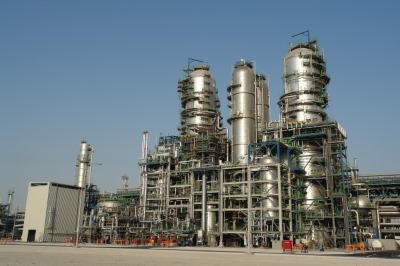
Oryx GTL plant
Eurasia Operations: Production of ethylene oxide
The Eurasia operations (EO) factory was founded together with the establishment of the Marl site in 1938, and after two and a half years of construction, operations started in December 1940 in Building 538 as a chlorohydrin process (milk of lime process). It supplied the raw material for the glycol factory, which had already been in operation since the summer of 1940 with bought-in goods from tank wagons.
After several process engineering developments and relocations, 36 employees work at the EO factory to ensure a smooth production process which is highly oriented towards the requirements of our customers.
Milestones
1940 to 1971
1940: In December start of ethylene oxide production in Building 538, today's amine factory, using the homogeneous catalytic chlorohydrin process. The capacity was 8000 t/a.
1956 – 1959: Commissioning of the two "modern " ethylene oxide plants, building 1117 West (1956) and East (1959), each with a capacity of 15,000 t/a using the "contact process". Silver catalysts on pumice stone were already used. The ethylene oxide catalyst factory (contact factory) in Building 1113 was also commissioned in 1956.
1967: Commissioning of the new EO plant Bau 1214, also as an air oxidation process but with a capacity three times higher (45 000 t/a))compared to the plants 1117 West and East.
1971: Capacity was then increased to 80 000 t/a and Building1117 West was closed. In 1969, the company switched to more powerful silver-impregnated alumina beads as catalysts.
1972 to 2001
1976 –1977: After two major explosions, conversion from air oxidation to oxygen oxidation using the Shell process with parallel two-stage capacity expansion to 160 000 t/a, the plant was put back into operation in 1977 with an exemplary safety system which is still in use today. In the same year the 1117 East plant was shut down.
1982: Significant improvement of ethylene oxide catalysts by conversion to caesium-doped silver lactate impregnated alumina ring extrudates, with own patents.
1988 – 1993: Further substantial improvement of the ethylene oxide catalysts by conversion to caesium-doped silver-ethylenediamine complex impregnated alumina ring extrudates, with further own patents.
1998: Cooperation with a catalyst supplier for commercial testing of advanced EO catalysts. Exit from own research and closure of the catalyst factory. Transfer from Hüls Ag to Contensio GmbH and then to Condea.
2001 to today
2001: Transition from the Condea to the Sasol.
2002: Completion of the process control system. The conversion was carried out step by step from 1998 onwards.
2004: Completion of the process control system. The conversion was carried out step by step from 1998 onwards.
2015: Merging of the control centre with the glycol plant, installation of two new large tank farms for ethylene oxide.
Important production milestones in Marl
1938: Foundation of Chemische Werke Hüls GmbH (owned 74% by I.G. Farbenindustrie AG and 26% by Bergwerksgesellschaft Hibernia.
1940: Start-up of the first production units (BUNA, and also Glycols, Ethylene Oxide, High Pressure Hydrogenation, MARLON®).
1997: At the turn of the year 1997/98 Hüls transformed into a strategic holding with 12 subsidiaries.
1998: Foundation of the Chemiepark Marl and acquisition of CONTENSIO Chemicals GmbH by RWE-DEA.
2000: Major capacity expansion of the Ethylene Oxide unit and implementation of a state of the art DCS.
2001: Acquisition of CONDEA by Sasol and foundation of Sasol Germany GmbH.
Plant Opening Nanjing
The new alkoxylation plant in Nanjing officially opened on 10 July 2019. The occasion was celebrated with a ceremony attended by several dignitaries from Sasol, the South African Embassy, the Nanjing Jiangbei New Materials High-Tech Park, business partners and customers.
The ceremony included a tour of the new plant and various speeches by dignitaries. To symbolise the enhanced ties between the two countries represented by the new plant, South African and Chinese drummers and dancers entertained the attendees with their unique talents. The event culminated in the formal ribbon cutting ceremony.


